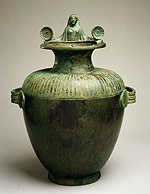New Greek and Roman Galleries
dal 19/4/2007 al 19/4/2008
Segnalato da
19/4/2007
New Greek and Roman Galleries
Metropolitan Museum of Art - MET, New York
After over 5 years of construction, the long-awaited opening concludes a 15-year project for the complete redesign and reinstallation of the Museum's collection of classical art. Returning to public view in the new space are about 6,000 longstored works from the collection. Centrepiece of the New Galleries is the Leon Levy and Shelby White Court. Curated by Carlos Picon.

Leon Levy and Shelby White Court Provides Dramatic Centerpiece for Display of the Metropolitan’s World-Renowned Classical Art Collection
Curated by: Carlos Picón
A spectacular "museum-within-the-museum" for the display of its extraordinary collection of
Hellenistic, Etruscan, South Italian, and Roman art – much of it unseen in New York for
generations – will open at The Metropolitan Museum of Art this April in its New Greek and
Roman Galleries. After more than five years of construction, the long-awaited opening will
conclude a 15-year project for the complete redesign and reinstallation of the Museum’s superb
collection of classical art. Returning to public view in the new space are thousands of longstored
works from the Metropolitan's collection, which is considered one of the finest in the
world. The centerpiece of the New Greek and Roman Galleries is the majestic Leon Levy and
Shelby White Court – a monumental, peristyle court for the display of Hellenistic and Roman
art, with a soaring two-story atrium.
"The New Greek and Roman Galleries are a milestone in an unprecedented building campaign –
more than a dozen years in the making – to construct anew within the framework of our historic
building, to make use of new methodologies while honoring the old, and to encourage our
visitors to look at ancient art in a new way," commented Philippe de Montebello, Director of
the Metropolitan Museum. "Some 6,000 works previously in storage, many of them collected
in the earliest years after the Museum's founding in 1870, will now be installed on two levels of
commodious new galleries by our brilliant team of curators under the leadership of Carlos
Picón, Curator in Charge of the Department of Greek and Roman Art, and with the outstanding
organizational abilities of Collections Coordinator Bill Gagen. As we celebrate this landmark
event, we remember with gratitude the generosity of our many friends, past and present, who
have made this possible – among them Shelby White and her late husband Leon Levy, and our
dear friends the late Bill Blass and the late Frank A. Cosgrove, Jr., whose generous gifts have
made possible this glorious new exhibition space for Greek and Roman art." Shelby White commented: "My late husband, Leon Levy, believed that by studying past civilizations we would better understand ourselves. What better setting to do that than these magnificent new galleries. I am thrilled."
"The fashion designer Bill Blass was a collector of truly discerning taste," noted Carlos Picón,
"with a passionate interest in the "classics" of many time periods – including antiquities.
Although he had been a loyal and active member of our departmental friends group for many
years, the bequest of half of his estate to the Department of Greek and Roman Art was
immensely gratifying and a complete surprise."
He continued: "Similarly, Frank Cosgrove – who had an interest in Greek and Roman art – also
made a very significant bequest to the Metropolitan, which was made known to the Museum
following his death in 1992. We feel certain that he would have been delighted to see these new
galleries. It is with great pleasure that the Museum places the names of these two men in the
galleries that contain superb examples of art that they both esteemed."
The New Greek and Roman Galleries, located in The Lamont Wing at the southern end of the
building, will house art created between about 900 B.C. and the early fourth century A.D.,
tracing the parallel stories of the evolution of Greek art in the Hellenistic period and the arts of southern Italy and Etruria, culminating in the rich and varied world of the Roman Empire. On
the first floor, contiguous to the central Leon Levy and Shelby White Court on three sides, are
galleries for Hellenistic and Roman art. The installation continues on the wholly redesigned
mezzanine level, where galleries for Etruscan art and the Greek and Roman study collection
overlook the court from two sides. Together, the astonishing assembly of works on display –
some never before seen by the public – will bring to life the visual and conceptual roots of
Western civilization.
The Metropolitan Museum of Art
1000 5th Avenue 82nd Street - New York



